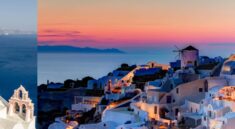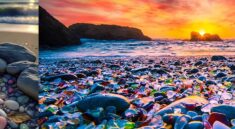Madeira, Portugal, is a captivating island destination known for its lush landscapes, rugged mountains, and vibrant flora. Situated in the Atlantic Ocean, this Portuguese archipelago offers a unique blend of natural beauty and cultural richness. Visitors can explore charming towns, indulge in local cuisine, and embark on outdoor adventures such as hiking along scenic trails. Madeira’s mild climate, diverse ecosystems, and welcoming atmosphere make it an enchanting destination for those seeking a harmonious blend of relaxation and exploration.
How to get there
To reach Madeira, Portugal, you typically follow these steps:
- Flights:
- Book a flight to Cristiano Ronaldo Madeira International Airport (FNC), the main airport on the island. Various airlines offer direct flights to Madeira from major European cities.
- Arrival in Funchal:
- Upon landing at FNC, you’ll arrive in Funchal, the capital of Madeira. Funchal is a bustling city with historical sites, restaurants, and cultural attractions.
- Accommodations:
- Choose accommodations based on your preferences and budget. Funchal offers a range of hotels, resorts, and guesthouses. You can also explore accommodations in other towns on the island.
- Transportation on the Island:
- Madeira has a well-developed transportation network. Consider renting a car for flexibility in exploring the island, or use public transportation, such as buses or taxis, to navigate between towns and attractions.
- Exploration:
- Visit key attractions on the island, including Pico do Arieiro, the Laurissilva Forest, and coastal areas. Engage in outdoor activities like hiking, exploring botanical gardens, and enjoying Madeira’s unique landscapes.
- Departure:
- When it’s time to leave, return to Cristiano Ronaldo Madeira International Airport for your departure.
Things to do
Madeira, Portugal, offers a diverse range of activities for visitors to enjoy. Here are some recommended things to do on the island:
- Levada Walks:
- Explore the unique irrigation channels known as levadas. These provide scenic walking paths through lush landscapes, offering opportunities to discover the island’s flora and stunning vistas.
- Pico do Arieiro:
- Hike to Pico do Arieiro, the third-highest peak on Madeira, for breathtaking panoramic views of the island and the Atlantic Ocean.
- Funchal Old Town (Zona Velha):
- Wander through the charming cobblestone streets of Funchal’s Old Town, filled with historic buildings, colorful houses, and local shops.
- Monte Palace Tropical Garden:
- Visit the Monte Palace Tropical Garden, featuring lush botanical gardens, exotic plants, and scenic viewpoints.
- Cabo Girão Skywalk:
- Experience the thrill of standing on the Cabo Girão Skywalk, a glass-floored viewing platform perched high above sea level, providing stunning coastal views.
- Laurissilva Forest:
- Explore the Laurissilva Forest, a UNESCO World Heritage site known for its ancient laurel trees and diverse ecosystem.
- Madeira Botanical Garden:
- Discover the Madeira Botanical Garden, home to a wide variety of plant species from around the world, set against the backdrop of Funchal.
- Camara de Lobos:
- Visit the picturesque fishing village of Camara de Lobos, known for its colorful boats, scenic harbor, and Winston Churchill-inspired viewpoint.
- Local Cuisine:
- Indulge in Madeiran cuisine. Try the traditional dish Espetada (grilled meat skewers), enjoy local fish, and savor Madeira wine.
- Santana Houses:
- Explore the traditional thatched-roof houses in Santana, a charming village that provides a glimpse into Madeira’s rural architecture.
- Water Activities:
- Engage in water activities such as whale watching, snorkeling, or taking a boat tour to appreciate Madeira’s marine life and coastal beauty.
- Cultural Events:
- Check for local cultural events, festivals, or markets happening during your visit to experience Madeira’s vibrant traditions.
Things not to forget
When visiting Madeira, Portugal, it’s important not to forget essential items to ensure a smooth and enjoyable experience. Here’s a checklist of things not to forget:
- Travel Documents:
- Bring your passport, travel insurance, and any necessary visas if required.
- Weather-Appropriate Clothing:
- Pack layers, including comfortable walking shoes, swimwear, and a light jacket. Be prepared for varying weather conditions.
- Sun Protection:
- Include sunscreen, sunglasses, and a hat to protect yourself from the strong sunlight, especially if you plan to spend time outdoors.
- Water Bottle:
- Stay hydrated by carrying a reusable water bottle, especially if you’ll be hiking or exploring outdoor areas.
- Electronics and Chargers:
- Bring your camera, smartphone, and chargers. A power adapter may be necessary if you have electronic devices with different plug types.
- Map or GPS:
- Carry a map or use GPS to navigate around the island, especially if you plan to explore remote areas.
- Hiking Gear:
- If you’re planning to hike, bring appropriate gear, including sturdy hiking boots, a backpack, and possibly trekking poles.
- First Aid Kit:
- Pack a basic first aid kit with items like bandages, pain relievers, and any necessary prescription medications.
- Cash:
- While credit cards are widely accepted, having some cash is advisable for smaller establishments or places that may not accept cards.
- Language Basics:
- Learn a few basic Portuguese phrases, as English may not be spoken everywhere, especially in more rural areas.
- Reusable Bags:
- Carry reusable bags for shopping, as single-use plastic bags may be limited or not provided.
- Snacks:
- Pack some snacks, particularly if you’re heading to remote areas where food options might be limited.
- Adapters and Converters:
- If you have electronic devices, check whether you need power adapters or voltage converters to match local standards.
- Emergency Contacts:
- Have a list of emergency contacts, including local contacts and the contact information for your country’s embassy or consulate.
- Respect for Nature:
- Follow Leave No Trace principles and respect the natural environment. Dispose of waste properly and adhere to any guidelines for eco-friendly tourism.
- COVID-19 Precautions:
- Follow any current health and safety guidelines related to COVID-19, including mask requirements and social distancing measures.
Best time to visit
The best time to visit Madeira depends on your preferences and the type of experience you’re seeking. Madeira generally enjoys a mild climate throughout the year, but there are variations in weather, crowd levels, and specific activities based on the season. Here’s a breakdown:
- Spring (March to May):
- Spring is an excellent time to visit Madeira. The weather is mild, and the island is covered in colorful blooms. It’s a great time for hiking, outdoor activities, and enjoying the lush landscapes. The tourist crowds are relatively low compared to the summer months.
- Summer (June to August):
- Summer is the high tourist season. The weather is warm, and it’s an ideal time for beach activities, water sports, and festivals. However, the island can be more crowded, and accommodation prices may be higher. If you enjoy lively atmospheres and warm temperatures, summer is a good choice.
- Autumn (September to November):
- Autumn is another excellent time to visit Madeira. The weather remains pleasant, and the summer crowds begin to dissipate. It’s a great time for hiking, exploring, and enjoying outdoor activities. The sea temperature is still suitable for swimming.
- Winter (December to February):
- Winter in Madeira is mild compared to many other European destinations. While it might not be the best time for traditional beach activities, it’s still possible to enjoy the island’s beauty. Winter is a quieter period with fewer tourists, making it a good time for those seeking a more relaxed experience.
- Festivals and Events:
- Consider any specific festivals or events you’d like to experience. Madeira hosts events throughout the year, such as the Flower Festival in spring and the New Year’s Eve fireworks in Funchal.
What is Madeira famous for?
Madeira is famous for several unique and distinctive features, making it a popular destination for tourists. Some of the things Madeira is renowned for include:
- Natural Beauty:
- Madeira is known for its breathtaking landscapes, featuring lush green mountains, dramatic cliffs, and picturesque valleys. The island’s diverse flora and fauna, including unique endemic species, contribute to its natural charm.
- Levadas:
- The intricate network of levadas, or irrigation channels, is a defining feature of Madeira. These channels crisscross the island and provide scenic walking paths through forests, offering hikers the chance to explore the island’s interior.
- Hiking Trails:
- Madeira offers an extensive network of hiking trails, including those leading to high peaks like Pico do Arieiro and Pico Ruivo. The diverse terrain caters to hikers of various skill levels and provides stunning panoramic views.
- Floral Splendor:
- The island is famous for its vibrant and diverse flora. Madeira’s botanical gardens, like the Monte Palace Tropical Garden and the Madeira Botanical Garden, showcase a wide variety of plant species, including the iconic Madeira orchid.
- Wine:
- Madeira wine, a fortified wine with a rich history, is renowned worldwide. The unique winemaking process involves aging the wine in barrels, resulting in distinct flavors. Visitors can explore wine cellars and taste different varieties of Madeira wine.
- Funchal’s Old Town (Zona Velha):
- The historic Old Town of Funchal is known for its charming cobblestone streets, traditional houses adorned with colorful doors, and vibrant street art. It’s a hub of local culture, featuring shops, restaurants, and historic sites.
- Cabo Girão Skywalk:
- The Cabo Girão Skywalk, a glass-floored viewing platform, is one of the highest cliffs in Europe. It offers panoramic views of the coastline and the Atlantic Ocean, providing an exhilarating experience for visitors.
- Festivals:
- Madeira hosts various festivals and events throughout the year. The Flower Festival, held in spring, showcases colorful floral displays, parades, and cultural activities. New Year’s Eve celebrations, particularly in Funchal, are renowned for their spectacular fireworks.
- Santana Houses:
- The traditional thatched-roof houses in Santana, a village on the northern coast, are iconic symbols of Madeira’s rural architecture. These triangular-shaped houses are popular among visitors.
- Toboggan Ride in Monte:
- The traditional Monte toboggan ride is a unique and thrilling experience. Visitors can take a wicker toboggan ride down the streets of Monte, guided by carreiros (drivers).
Madeira’s combination of natural beauty, cultural richness, and outdoor activities make it a multifaceted destination that appeals to a wide range of travelers.
Is Madeira in Portugal or Spain?
Madeira is an autonomous region of Portugal. It is not part of Spain. Madeira, along with the neighboring island of Porto Santo and some smaller uninhabited islands, forms the Madeira Archipelago. The archipelago is situated in the Atlantic Ocean, approximately 1,000 kilometers southwest of mainland Portugal. Madeira has its own local government and enjoys a high degree of autonomy within the Portuguese Republic. Funchal, located on the island of Madeira, is the capital of the Madeira Autonomous Region.
Is it expensive in Madeira?
Madeira is generally considered to be more affordable than many other European destinations, but the cost of living and travel expenses can vary based on personal preferences and travel habits. Here are some factors to consider regarding the cost of living in Madeira:
- Accommodation:
- Accommodation costs can vary depending on the type of lodging you choose. Options range from budget-friendly hostels and guesthouses to upscale hotels and resorts.
- Dining:
- Eating out in Madeira can be reasonably priced, especially if you opt for local or traditional restaurants. However, dining costs may vary depending on the establishment and your choices.
- Transportation:
- Public transportation and taxis are relatively affordable, but renting a car might be a significant expense. It’s important to consider your transportation needs, especially if you plan to explore the island.
- Activities and Excursions:
- The cost of tours, activities, and excursions can vary. Some activities, such as hiking or exploring natural sites, may be low-cost or even free, while others, like boat tours or cultural experiences, may have associated fees.
- Entertainment:
- Prices for entertainment, such as entrance fees to attractions, museums, or events, can vary. It’s a good idea to plan your activities and budget accordingly.
- Shopping:
- Souvenirs, local crafts, and other items may vary in price. It’s advisable to compare prices and shop in local markets for unique, budget-friendly finds.
- Currency Exchange:
- As Madeira is part of Portugal, the currency used is the Euro (EUR). It’s essential to be aware of exchange rates and potential fees when exchanging currency.
Image credits: bloximages.chicago2





